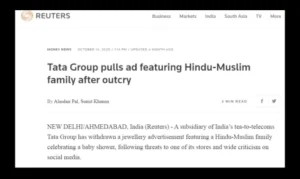What happens if you ill-time an ad? What happens if you create an ad with a social message but can’t stand by it? What happens if you do this once, and then do it all over again within the month? On the other hand, what happens when your brand is on a downslide but you get the ad right?

Two parallel brand stories unfolded this festival season – Tanishq and Facebook. Let me break it down for you.
That the Tanishq ads for Diwali season 2020 were a fiasco is an understatement. The biggest loser has been the parent brand – Tata – which has ironically remained aligned with ‘nationalist sentiment’ for decades.
Now let us be clear – the problem with the first Tanishq ad was definitely not its content. In fact, as a marketer I felt the product was beautifully positioned. The ad showed the members of an entire family wearing the product in mesmerising aesthetics. The problem was the timing!

The ad was launched ahead of Diwali – a Hindu festival – but actually had nothing to do with the festival. It was a simple touching human interest story of a Muslim family taking care of its pregnant Hindu daughter-in-law. A great ad for Daughter’s Day, even Women’s Day, perhaps. But launched on Diwali it knocked right at the door of political debate.
At this point it seemed the idea was to create debate and news – maybe stir up the sluggish market a little. And that is what happened. Tanishq was suddenly trending across all social media platforms. But the brand was not prepared for what was to come. The bigger blow was not the ad but the decision to pull it down.
The story, as we know, doesn’t end here. Already riding this negative wave the brand launched another ad which showed four women celebrities talking about how they planned to spend Diwali this year. The very first celebrity emphasized not using crackers. Frankly, this was a far more muted positioning compared to the last ad. Once again there was a backlash and once again the brand pulled down the ad.
The entire episode stayed in news for days moving from the front pages to edit columns, inspiring memes, hashtags, cartoons and causing considerable damage to the brand image. The shock waves of it also reached Tata, the parent brand, denting its credible track record as well.
Sample this headline run by Reuters:

But there was another commercial around the same time. Facebook launched a short film produced in the backdrop of lockdown, Covid 19, unemployment, Vocal For Local, and leading right up to Diwali. This was a perfect tear-jerker. It positioned Facebook as a platform that brings people together and, importantly, provides solutions. Unlike Tanishq, Facebook as a brand has seen a decline, caught as it is in a fiery political environment. But this film helped it rebuild the emotional connection. With perfect timing and positioning, the film quickly went viral gathering goodwill, likes and positive publicity for the brand.
Now, the Tanishq ad when compared to that of Facebook raises judgement questions. In the case of Tanishq, the primary aim to position the product was clouded by social messaging. The brand waded into one controversy after another without being prepared to rough it out. While it is often argued that any publicity is good, but one has to be mindful of the cost. Moreover in the case of Tanishq, people were not prepared for a positioning of this sort. Consider a brand like Amul that chooses to comment on every current debate and gets away with it. This is majorly because being ‘opinionated’ and ‘bold’ is a part of the utterly-butterly and mischievous image of the brand, giving it considerable room to manoeuvre. The same does not apply to Tanishq.
When you are in the business of the marketing, you know for sure that some ads are likely to work better than expected just as some might unexpectedly bomb. What you do after an ad failure makes a world of a difference and a retreat is not always the safest option.

